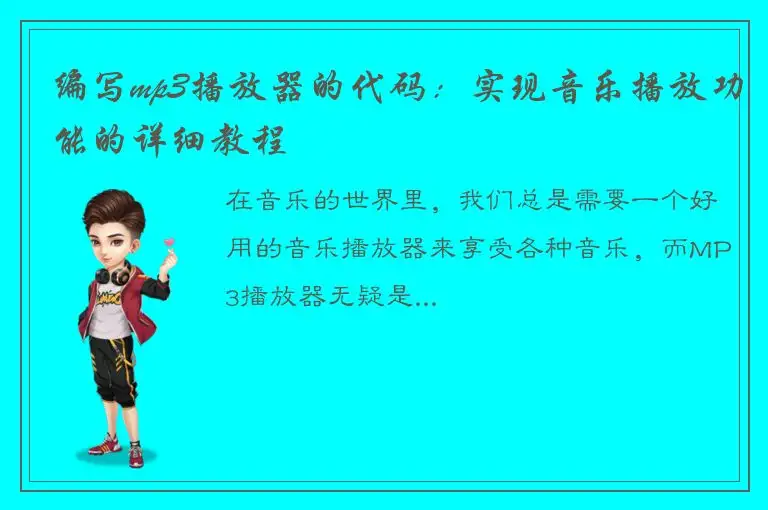在音乐的世界里,我们总是需要一个好用的音乐播放器来享受各种音乐,而MP3播放器无疑是最方便实用的选择之一。本文将为您详细介绍如何编写MP3播放器代码,让您实现音乐播放功能。

1. 开发环境
首先需要选择一个适合开发的环境,可以选择Visual Studio或其他编程软件。需要安装相应的库文件,如开源的FFmpeg库和SDL库,都是常用的用于音视频以及多媒体的库文件。
2. 引入头文件
在代码的开头引入一些必要的头文件,如以下所示:
#include "stdafx.h"
#include
#include "SDL.h"
#include "SDL_audio.h"
#include "SDL_types.h"
#include "SDL_thread.h"
#include "SDL_mutex.h"
#include "SDL_endian.h"
#include "SDL_Stdinc.h"
#include
#include
#include
#include
#include
3. 实现音频解码
接下来需要实现音频的解码功能,这里我们使用FFmpeg库中的avcodec_decode_audio4()函数来解码音频,示例代码如下:
int audio_decode_frame(AVCodecContext *aCodecCtx, uint8_t *audio_buf, int buf_size)
{
static AVPacket pkt;
static uint8_t *audio_pkt_data = NULL;
static int audio_pkt_size = 0;
int len1, data_size = 0;
for (;;)
{
while (audio_pkt_size > 0)
{
int got_frame = 0;
len1 = avcodec_decode_audio4(aCodecCtx, frame, &got_frame, &pkt);
if (len1 < 0)
{
audio_pkt_size = 0;
break;
}
audio_pkt_data += len1;
audio_pkt_size -= len1;
data_size = 0;
if (got_frame)
{
data_size = av_samples_get_buffer_size(NULL,
aCodecCtx->channels,
frame->nb_samples,
aCodecCtx->sample_fmt,
1);
assert(data_size <= buf_size);
memcpy(audio_buf, frame->data[0], data_size);
}
if (data_size <= 0)
continue;
return data_size;
}
if (pkt.data)
av_free_packet(&pkt);
if (quit)
return -1;
if (packet_queue_get(&audioq, &pkt, 1) < 0)
return -1;
audio_pkt_data = pkt.data;
audio_pkt_size = pkt.size;
}
}
4. 实现音频播放
通过SDL库中的SDL_OpenAudio()和SDL_PauseAudio()函数来打开和暂停音频播放。当音频播放结束时,需要通过SDL库中的SDL_CloseAudio()函数来关闭音频播放,示例代码如下:
void audio_callback(void *userdata, Uint8 *stream, int len)
{
AVCodecContext *aCodecCtx = (AVCodecContext *)userdata;
int len1, audio_size;
static uint8_t audio_buf[(MAX_AUDIO_FRAME_SIZE * 3) / 2];
static unsigned int audio_buf_size = 0;
static unsigned int audio_buf_index = 0;
while (len > 0)
{
if (audio_buf_index >= audio_buf_size)
{
audio_size = audio_decode_frame(aCodecCtx, audio_buf, sizeof(audio_buf));
if (audio_size < 0)
{
audio_buf_size = 1024;
memset(audio_buf, 0, audio_buf_size);
}
else
{
audio_buf_size = audio_size;
}
audio_buf_index = 0;
}
len1 = audio_buf_size - audio_buf_index;
if (len1 > len)
len1 = len;
memcpy(stream, (uint8_t *)audio_buf + audio_buf_index, len1);
len -= len1;
stream += len1;
audio_buf_index += len1;
}
}
5. 将音频加入队列
在程序运行过程中,需要将音频数据加入到队列中,以确保音频按照预期播放。可以通过SDL_Thread对象和SDL_Cond对象来实现队列的添加和移除,示例代码如下:
int packet_queue_put(PacketQueue *q, AVPacket *pkt)
{
AVPacketList *pkt1;
if (av_dup_packet(pkt) < 0)
{
return -1;
}
pkt1 = (AVPacketList*)av_malloc(sizeof(AVPacketList));
if (!pkt1)
return -1;
pkt1->pkt = *pkt;
pkt1->next = NULL;
SDL_LockMutex(q->mutex);
if (!q->last_pkt)
q->first_pkt = pkt1;
else
q->last_pkt->next = pkt1;
q->last_pkt = pkt1;
q->nb_packets++;
q->size += pkt1->pkt.size;
SDL_CondSignal(q->cond);
SDL_UnlockMutex(q->mutex);
return 0;
}
6. 实现音频播放控制
最后需要实现音频播放控制,可以通过控制音频播放的延迟时间来实现控制,如示例代码:
void loop_play()
{
SDL_Init(SDL_INIT_VIDEO | SDL_INIT_AUDIO | SDL_INIT_TIMER);
AVFormatContext *pFormatCtx = NULL;
int i, videoStream, audioStream;
AVCodecContext *pCodecCtx = NULL;
AVCodec *pCodec = NULL;
AVPacket *packet = av_malloc(sizeof(AVPacket));
AVFrame *frame = av_frame_alloc();
SDL_Event event;
SDL_AudioSpec wantedSpec, spec;
PacketQueue audioq;
FILE *pFile = fopen("music.mp3", "rb");
if (!pFile)
{
return;
}
av_register_all();
if (SDL_Init(SDL_INIT_AUDIO | SDL_INIT_CONTROLLER | SDL_INIT_TIMER | SDL_INIT_VIDEO | SDL_INIT_EVENTS) != 0)
{
return;
}
pFormatCtx = avformat_alloc_context();
if (avformat_open_input(&pFormatCtx, "", NULL, NULL) != 0)
{
return;
}
if (avformat_find_stream_info(pFormatCtx, NULL) < 0)
{
return;
}
av_dump_format(pFormatCtx, 0, "", 0);
audioStream = -1;
for (i = 0; i < pFormatCtx->nb_streams; i++)
{
if (pFormatCtx->streams[i]->codecpar->codec_type == AVMEDIA_TYPE_AUDIO)
{
audioStream = i;
break;
}
}
if (audioStream == -1)
{
return;
}
avcodec_parameters_to_context(pCodecCtx, pFormatCtx->streams[audioStream]->codecpar);
pCodec = avcodec_find_decoder(pCodecCtx->codec_id);
if (!pCodec)
{
return;
}
if (avcodec_open2(pCodecCtx, pCodec, NULL) < 0)
{
return;
}
packet_queue_init(&audioq);
wantedSpec.freq = pCodecCtx->sample_rate;
wantedSpec.format = AUDIO_S16SYS;
wantedSpec.channels = pCodecCtx->channels;
wantedSpec.silence = 0;
wantedSpec.samples = 1024;
wantedSpec.callback = audio_callback;
wantedSpec.userdata = pCodecCtx;
if (SDL_OpenAudio(&wantedSpec, &spec) < 0)
{
return;
}
av_read_play(pFormatCtx);
SDL_PauseAudio(0);
int ret = 0;
while (1)
{
SDL_Delay(10);
SDL_PollEvent(&event);
switch (event.type)
{
case SDL_QUIT:
quit = 1;
SDL_CloseAudio();
SDL_DestroyWindow(window);
SDL_Quit();
exit(0);
break;
case SDL_KEYDOWN:
switch (event.key.keysym.sym)
{
case SDLK_SPACE:
if (pause)
{
SDL_PauseAudio(0);
pause = 0;
}
else
{
SDL_PauseAudio(1);
pause = 1;
}
break;
}
break;
}
if (av_read_frame(pFormatCtx, packet) >= 0)
{
if (packet->stream_index == audioStream)
{
packet_queue_put(&audioq, packet);
}
else
{
av_packet_unref(packet);
}
}
while (audioq.size > MAX_AUDIO_SIZE && quit == 0)
{
SDL_Delay(10);
}
}
SDL_CloseAudio();
SDL_Quit();
return;
}
综上所述,MP3播放器代码实现起来并不难,只需要在选择合适的环境和库文件的基础上,按照上述步骤进行开发即可。通过这种方式,我们可以自己编写音乐播放器,并实现音乐播放功能。希望这篇文章能够为您提供实用的帮助。




 QQ客服专员
QQ客服专员 电话客服专员
电话客服专员